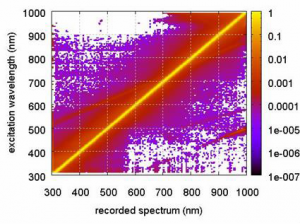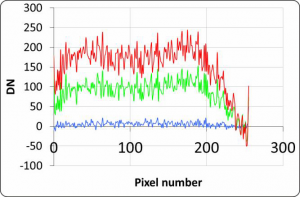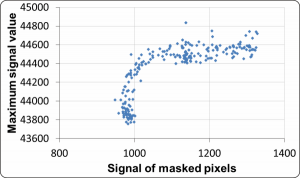The purpose of this work package is to establish and document protocols and best practice to practically verify the performance of FRM OCR and to organize Laboratory Calibration Exercise (LCE-2).
D-130 Technical Report (TR-5) Protocols and Procedures to Verify the Performance of Field Ocean Colour Radiometers (OCR) used for Satellite Validation
This report will serve as the master guide for the participants of LCE-2. It will review critically the methodology to be used by teams in practical verification of the of FRM OCR using reference to SI traceable calibration sources. It will also define how to establish, present and maintain uncertainty budgets for measurement data. TR-5 will describe calibration protocols for all relevant parameters affecting the measurements of OCR. Tartu Observatory has already characterised several parameters of their own TriOS RAMSES OCRs such as nonlinearity (Figure 4-7.), stray light (Figure 4-8.), temperature dependence of dark signal (Figure 4-9.) and radiometric sensitivity (Figure 4-10.). Lessons learned from previous OCR intercomparison exercises will be considered (Hooker et al. 2002; Meister et al. 2002; Zibordi et al. 2012). As FRM OCR measurements include measurement of downwelling solar irradiance, literature on this topic will also be reviewed (Galleano et al. 2013, Habte et al. 2014, Martínez-Lozano et al. 2003; Labajo et al. 2004).

Figure 4-7. Nonlinearity of TrOS RAMSES.

Figure 4-8. Stray light pattern of TriOS RAMSES.

Figure 4-9. Dark signal pattern of TriOS RAMSES at different ambient temperatures.

Figure 4-10. Temperature dependence of radiometric sensitivity of TriOS RAMSES. Signal of masked pixels is used as proxy for temperature of the sensor.
D-140 Implementation plan for LCE-2
TO will publish a global open invitation for LCE-2 to involve as many active users of Field Ocean Color Radiometers as possible. Information about participating instruments will be gathered and Tartu Observatory will work together with the participants in order to make sure that all the necessary hardware for mounting the instruments in the lab and during the outdoor intercomparison will be available for the time of LCE-2. The OC radiometers participating in the exercise will be gathered to TO prior LCE-2 for absolute calibration. Participants will join afterwards for comparison measurements. TO will help the participants with all aspects concerning travel, accommodation, customs, shipping of instruments, etc.
D-150 LCE-2 campaign to verify the performance of FRM OCR used for Satellite Validation traceable to SI
The LCE-2 will serve as a preparation stage for the AAOT-FICE field intercomparison exercise. The LCE-2 can be divided into three sub-tasks:
a) Provide SI-traceable radiometric calibration for participating radiometers
b) Organize indoor intercomparison in controlled environment
c) Organize outdoor intercomparison over terrestrial water surface
It is not feasible to calibrate all parameters (wavelength accuracy, stray light, field of view, temperature stability, linearity, angular response for irradiance sensors, etc.) of all the participating instruments during LCE-2. However, protocols and best practices for all these calibrations will be included in the TR-5 and all participants of LCE-2 are encouraged to have their instruments as well characterised as possible prior to LCE-2. Absolute radiometric calibration will be performed for all the participating radiometers during LCE-2.
LCE-2 will take place before AAOT-FICE in 15 – 21 May 2017. It will serve as a training session for the participants of AAOT-FICE as well as provide SI-traceable radiometric calibration of participating radiometers. Previous inter-comparison of ocean colour radiometers (Zibordi et al. 2012) has shown that the consistency of results improved when all the instruments participating in the inter-calibration were radiometrically calibrated in the same laboratory.
a) Provide SI-traceable radiometric calibration for participating radiometers
Usually calibration facilities are not available for end-users. The instruments are sent for calibration to an NMI or a calibration laboratory which has traceability to SI scale via an NMI. Therefore, the end-users are not required to be able to carry out laboratory calibration of their instruments. TO, the organizer of LCE-2, under supervision of an NPL representative, will be responsible for radiometric calibration of the participating radiometers. This will eliminate differences in calibration due to variation in calibration facilities and personnel. Prior to LCE-2, TO will take part in LCE-1 to verify the SI-traceability of reference irradiance and radiance sources.
b) Organize indoor intercomparison of radiance and irradiance radiometers in controlled environment
Each participant will carry out measurements of stable radiance and irradiance sources using their own radiometers. The inter-comparison will be organised as “blind” i.e. the participants will not know the radiance and irradiance levels of the sources before the inter-comparison and are not allowed to compare results during the LCE-2. Prior to the commencement of measurements a detailed training session will take place to assure that all participants are fully aware of the relevant procedures and protocols.
c) Organize outdoor inter-comparison over a terrestrial water surface
Each participant will carry out radiance and irradiance measurements over terrestrial water surface. Prior to the commencement of measurements a detailed training session will take place to assure that all participants are fully aware of the relevant procedures and protocols. The outdoor intercomparison will take place at Lake Kääriku, Estonia. Lake Kääriku is an eutrophic lake with a muddy bottom. Maximum depth is 5.9 m with an average of 2.6 m. The water colour is greenish-yellow, measured transparency (Secchi disk depth) is 1.8 m. The measurements will be made from a stable platform.
The outcomes of LCE-2 will be:
- SI-traceable radiometric calibration of radiometers participating in AAOT-FICE. The calibration of all the instruments will be from the same laboratory and done by the same personnel, thus eliminating possible differences in calibrations caused by differences between calibrating laboratories.
- Comparison between previous and new radiometric calibration. The radiometers participating in LCE-2 will have radiometric calibration from either manufacturer or independent calibration laboratory prior to the LCE-2. These calibration coefficients can be compared to SI-traceable calibrations done during LCE-2 by TO.
- Comparison of differences caused by instrument operators. Each participant will make their own measurements of the same stable source. The differences between measurement results contain the human factor of the instrument operator.
- Participants of LCE-2 can practice following the FICE protocol presented in TR-8 prior to participating in the AAOT-FICE.
More information about organization of LCE-2 can be found here.
D-160 Data from LCE-2
All data collected during the LCE-2 will be collected into digital data package and made public at the project web site. The datapackage will include the measurement protocol and procedures (TR-5), calibration results of the radiometers, measurement results under controlled laboratory conditions and over terrestrial water surface, guidelines for uncertainty evaluation, uncertainty budgets, and any other relevant data involved.
D-170 Technical Report (TR-6): “Results from the First FRM4SOC Field Ocean Colour Radiometer Veri fication Round Robin Campaign”
The results of the LCE-2 will be presented as TR-6, and possibly as a peer-reviewed journal paper. The LCE-2 will give information of the feasibility of FRM in controlled laboratory environment while measuring a stable source, encompassing the aspects of instrument calibration as well as end-user operation of the instrument. Building upon the indoor intercomparison the measurements are repeated in outdoor environment in closer to real-life conditions while still keeping to a minimum possible variables affecting the measurement results. Together with NPL an uncertainty budget for the end-to-end measurement process will be calculated for the radiometers involved in the LCE-2.
- Galleano, R., Zaaiman, W., Strati, C., Bartocci, S., Pravettoni, M., Marzoli, M., Fucci, R., Leanza, G., Timò, G., Minuto, A. and Catena, M., 2013. Second international spectroradiometer intercomparison: preliminary results and impact on PV device calibration. Ies.
- Habte, A., A. Andreas, L. Ottoson, C. Gueymard, G. Fedor, S. Fowler, J. Peterson, et al. 2014. Indoor and Outdoor Spectroradiometer Intercomparison for Spectral Irradiance Measurement. United States.
- Hooker, S.B., Firestone, E.R., McLean, S., Sherman, J., Small, M., Lazin, G., Zibordi, G., Brown, J.W. and McClain, C.R., 2002. The seventh SeaWiFS intercalibration round-robin experiment (SIRREX-7), March 1999.
- Labajo, A., Cuevas, E. and de la Morena, B., 2004. The First Iberian UV-Visible Instruments Intercomparison. Instituto Nacional de Meterorologia (INM, Spain).
- José A. Martínez-Lozano, Maria P. Utrillas, Roberto Pedrós, Fernando Tena, Juan P. Díaz, Francisco J. Expósito, Jerónimo Lorente, Xavier de Cabo, Victoria Cachorro, Ricardo Vergaz, and Virgilio Carreño, 2003: Intercomparison of spectroradiometers for global and direct solar irradiance in the visible range. J. Atmos. Oceanic Technol., 20, 997–1010.
- Meister, G., Abel, P., McClain, C., Barnes, R., Fargion, G., Cooper, J., Davis, C., Korwan, D., Godin, M. and Maffione, R., 2002. The first SIMBIOS radiometric intercomparison (SIMRIC-1), april-september 2001. Vancouver
- Zibordi, G., Ruddick, K., Ansko, I., Moore, G. F., Kratzer, S., Icely, J. D., Reinhart, A. In situ determination of the remote sensing reflectance: an inter-comparison, Ocean Sci., 8, 567–586, 2012.
